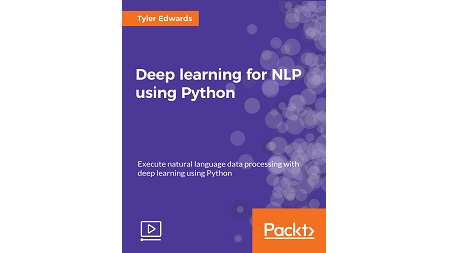
English | MP4 | AVC 1920×1080 | AAC 48KHz 2ch | 1h 51m | 226 MB
Learn how to apply the concepts of deep learning to a diverse range of natural language processing (NLP) techniques
In this course, you’ll expand your NLP knowledge and skills while implementing deep learning tools to perform complex tasks. You’ll start by preparing your environment for NLP and then quickly learn about language structure and how we can break sentences down to extract information and uncover the underlying meaning. After reviewing the basics, we’ll move on to speech recognition and show how deep learning can be used to build speech recognition applications.
In order to give you the best hands-on experience, the course includes a wide variety of practical real world examples. You’ll discover how a Naive Bayes algorithm can be used for Binary and Multiclass text classification. We’ll show you how a binary classifier can be used to determine if a product review would best be classified as positive or negative. You’ll also learn how document classifiers can be used to predict information about the author of a text like their age, gender, or where they’re from.
Finally speech recognition systems will be introduced and you’ll learn how to apply deep learning techniques to build your own speech to text application. We’ll walk through two examples, step-by-step, showing how to build and train neural networks to understand spoken audio inputs.
By the end of this tutorial, you’ll have a better understanding of NLP and will have worked on multiple examples that implement deep learning to solve real-world spoken language problems. In particular, you’ll be able to discover useful information and extract key insights from piles of natural language data.
In this course you will be familiarized with how deep learning can be applied for natural language processing in Python. The course is compartmentalized in a manner that it would allow you to progress at your own pace
What You Will Learn
- Learn how to build speech to text applications using deep learning.
- Implement deep learning with a convolution neural network, and a recurrent neural network using long-short term memory
- See how you can load, access, and use the built-in corpora of NLTK for linguistic research
- Create conditional frequency distributions for a given text dataset
- Utilize a lexical resource to organize text data and create relationships
- Process raw text with NLTK by implementing an NLP pipeline and implementing tokenization
- Use document classification algorithms to extract information about a text like the age and sentiment of the author
- Discover how the Naive-Bayes algorithm can be used for Binary and Multiclass text classification
- Understand the concepts of hierarchy of ideas, chunking, and chinking
- Use NLP to reduce long strings of information that can be difficult to analyze down into shorter, more manageable chunks of text data
Table of Contents
Working with a Text Corpus
1 The Course Overview
2 Access and Use the Built-in Corpora of NLTK
3 Loading a Corpus
4 An Example of Conditional Frequency Distribution
5 An Example of a Lexical Resource
Processing Raw Text with NLTK
6 Working with an NLP Pipeline
7 Implementing Tokenization
8 Regular Expressions
9 Regular Expressions Used in Tokenization
A Practical Real World Example of Text Classification
10 Naive Bayes Text Classification
11 Age Prediction Application
12 Document Classifier Application
Finding Useful Information from Piles of Text
13 Hierarchy of Ideas or Chunking
14 Chunking in Python NLTK
15 Chinking (Non-Chunk Patterns) in NLTK
Developing a Speech to Text Application Using Python
16 Python Speech Recognition Module
17 Speech to Text with Recurrent Neural Networks
18 Speech to Text with Convolutional Neural Networks – Part One
19 Speech to Text with Convolutional Neural Networks – Part Two
Resolve the captcha to access the links!